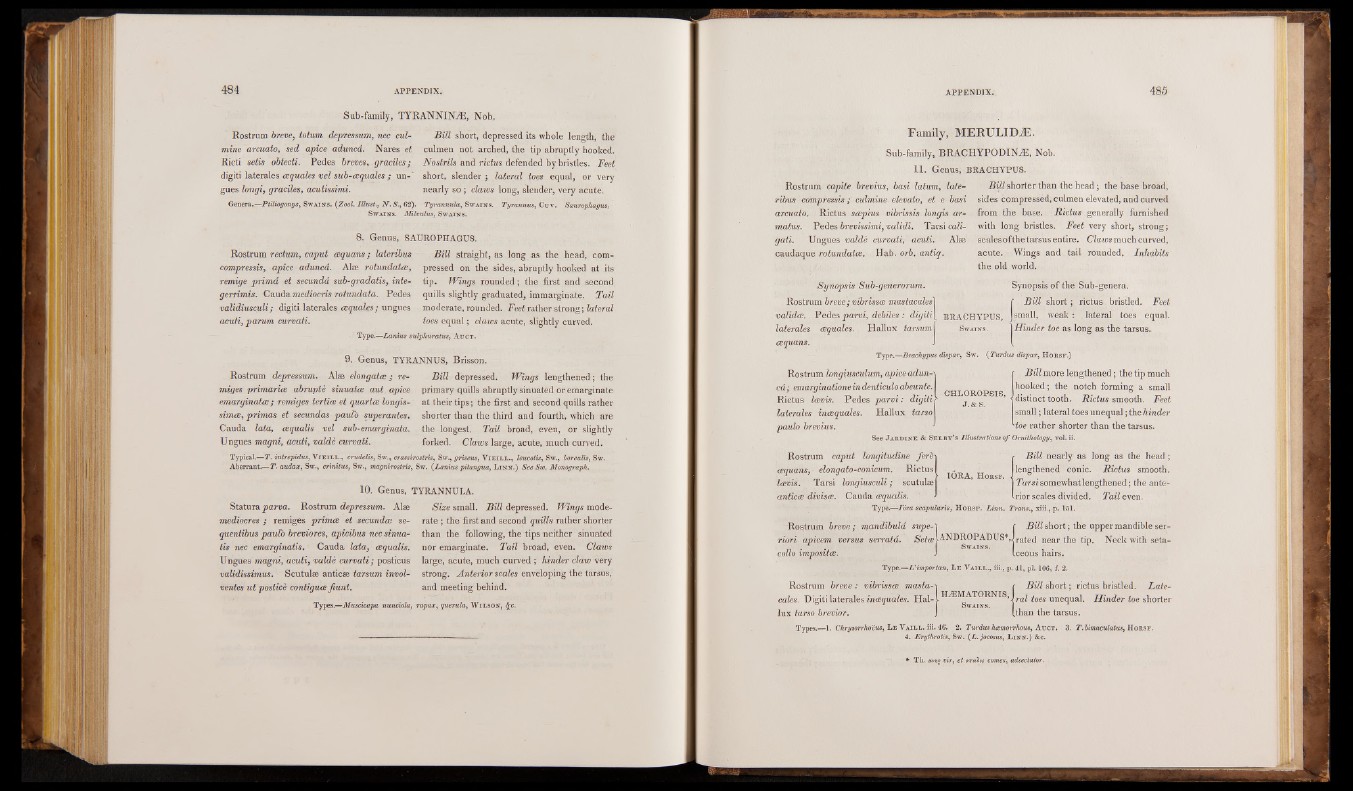
Sab-family, TYRANNIN^E, Nob.
Rostrum breve, totum depressum, nec cul- Bill short, depressed its whole length, the
mine arcuato, sed apice aduncd. Nares et culmen not arched, the tip abruptly hooked.
Ricti setis obtecti. Pedes breves, graciles; Nostrils and rictus defended by bristles. Feet
digiti laterales (Equates vel sub-cequales; un-' short, slender ; lateral toes equal, or very
gues longi, graciles, acutissimi. nearly so ; claws long, slender, very acute.
Genera.—Ptiliogonys, Swains. (Zool. Illust., N . S ., 62). Tyrannula, Swains. Tyrannus, Ctrv. Saurophagus,
Swains. Milvulus, Swains.
8. Genus, SAUROPHAGUS.
Rostrum rectum, caput cequans; lateribus
compressis, apice aduncd. Alee rotundatce,
■ remige primd et secunda sub-gradatis, inte-
gerrimis. Cauda mediocris rotundata. Pedes
validiusculi ; digiti laterales cequales ; ungues
acuti, parum curvati.
Bill straight, as long as the head, compressed
on the sides, abruptly hooked at its
tip. Wings rounded; the first and second
quills slightly graduated, immarginate. Tail
moderate, rounded. Feet rather strong; lateral
toes equal; claws acute, slightly curved.
Type.—Lanins sulphuratus, Atjct.
9. Genus, TYRANNUS, Brisson.
Rostrum depressum. Alae elongates; re-
miges primaries abrupte sinuatce out apice
emarginatce; remiges tertice et quartce longis-
simee, primas et secundas paulb superantes.
Cauda lata, cequalis vel sub-emarginata.
Ungues magni, acuti, valde curvati.
depressed. Wings lengthened ; the
Bill
primary quills abruptly sinuated or emarginate
at their tips; the first and second quills rather
shorter than the third and fourth, which are
the longest. Tail broad, even, or slightly
forked. Claws large, acute, much curved.
Typical.—T. intrepidus, Vie il l ., crudelis, Sw., crassirostris, Sw., griseus, Vie il l ., leucotis, Sw., borealis, Sw.
Aberrant.—T. audax, Sw., crinitus, Sw., magnirostris, Sw. (Lanius pitangua, Lin n.) See Sw. Monograph.
10. Genus, TYRANNULA.
Statura parva. Rostrum depressum. Alæ
mediocres ; remiges primoe et secundce se-
quentibus paulb breviores, apicibus nec sinua-
tis nec emarginatis. Cauda lata, cequalis.
Ungues magni, acuti, valdè curvati; posticus
validissimus. Scutulæ anticæ tarsum invol-
ventes ut posticè contiguoe fiunt.
Size small. Bill depressed. Wings moderate
; the first and second quills rather shorter
than the following, the tips neither sinuated
nor emarginate. Tail broad, even. Claws
large, acute, much curved ; hinder claw very
strong. Anterior scales enveloping the tarsus,
and meeting behind.
Types.—Muscicapa nunciola, rapax, querula, Wilson, fyc.
Family, MERULIDÆ.
Sub-family, BRACHYPODINÆ, Nob.
11. Genus, BRACHYPUS.
Rostrum capite brevius, basi latum, lateribus
compressis ; culmine elevato, et e basi
arcuato. Rictus scepius vibrissis longis ar-
matus. Pedes brevissimi, validi. Tarsi cali-
gati. Ungues valdè curvati, acuti. Alæ
caudaque rotundatce. Hab. orb. antiq.
Bill shorter than the head; the base broad,
sides compressed, culmen elevated, and curved
from the base. Rictus generally furnished
with long bristles. Feet very short, strong;
scales ofthe tarsus entire. Claws much curved,
acute. Wings and tail rounded. Inhabits
the old world.
Synopsis Sub-generorum. Synopsis of the Sub-genera.
Rostrum breve; vibrissce mastacales\ t ..Bill short; rictus bristled. Feet
validce. Pedes parvi, debiles : digiti [ BRACHYPUS, J small, weak: lateral toes equal.
laterales cequales. Hallux tarsum I Swains. 1 Hinder toe as long as the tarsus.
cequans. J t
Type.—Brachypus dispar, Sw. ( Turdus dispar, H oesf.)
Rostrum lohgiusculum, apice adun--\ r Bill more lengthened; the tip much
ca: emarqinationeindenticuloabeunte.l 1 hooked; the notch forming a small
Rictus Icevis. Pedes parvi: digiti)■ j * j distinct tooth. Rictus smooth. Feet
laterales incequales. Hallux torso I small; lateral toes unequal; the hinder
paulo brevius. ' ^toe rather shorter than the tarsus.
See Jardine & Selby’s Illustrations of Ornithology, vol. ii.
Rostrum caput longitudine ferb-t t Bill nearly as long as the head ;
cequans, elongato-conicum. Rictus I jqra jj I lengthened conic. Rictus smooth.
Icevis. Tarsi longiusculi ; scutulaej | * j Tarsi somewhat lengthened; the an teanticce
divisce. Cauda cequalis. ' trior scales divided. Tail even.
Type.—lora scapularis, Horsf. Linn. Trans., xiii., p. 151.
Rostrum breve ; mandibula siipe-l r Bill short; the upper mandible serriori
apicem versus serratd. rated near the tip. Neck with setacollo
impositce. J tceous hairs.
Type.—Vimportan, Le Vaill., iii., p. 41, pi. 106, f. 2.
Rostrum breve : vibrissce masta-•» r Bill short; rictus bristled. Latecales.
Digiti laterales incequales. Hal-1 ^ MATORNIS, I ^ unequal. Hinder toe shorter
lux tarso brevior. J [than the tarsus.
Types.—1. Chrysorrhoeus, Lb Vaill. iii. 46. 2. Turdus hamorrhous, Atjct. 3. T.bimaculatus, Horsf.
4. Erythrotis, Sw. (£. jocosus, Linn.) &c.
Th. «»«g vir, et oxecios comes, adsectator.